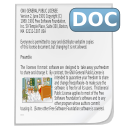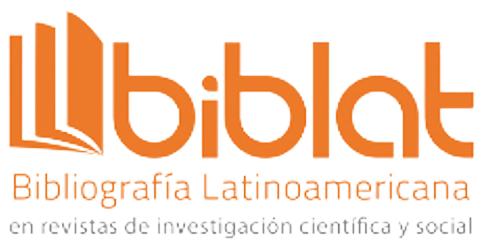Obesity awareness in Latin America in health centers using a decision tree
Abstract
This paper seeks to raise awareness about localized obesity in Latin America and its health centers, inciting to reduce obesity in the population, taking as a tool a software that from the data taken in the research can determine the levels of obesity in a patient and recommend some ways to improve health using techniques related to Artificial Intelligence where the model applied to the data can be observed which are the people with a higher degree of obesity and analyze their respective causes.
Downloads
References
. Miguel Soca, P. y Niño Peña, A., 2009. Consecuencias de la obesidad . [en línea] Scielo.sld.cu. Disponible en: <http://scielo.sld.cu/scielo.php?script=sci_arttext&pid=S1024-94352009001000006> [Consultado el 25 de junio de 2022].
. Martínez Gárate, I., Valdés del Olmo, L., Bayona González, A. y Martínez Castellanos, J., 2021. Relación entre la obesidad y el estrés laboral: una revisión sistemática . [en línea] scielo.isciii. Disponible en: <https://scielo.isciii.es/scielo.php?pid=S0465-546X2021000200112&script=sci_arttext&tlng=pt> [Consultado el 25 de junio de 2022].
. Bouharati S. et. al.,2012, Prevention of Obesity using Artificial Intelligence Techniques. International Journal of Science and Engineering Investigations. vol. 1, num. 9.
. Marmett, B., Böek Carvalhoa, R., Santos Fortesb, M., Cazellab, S., 2017. Artificial Intelligence technologies to manage obesity. vol. 30, num. 2. (2018). pag. 73-79. DOI: https://doi.org/10.14295/vittalle.v30i2.7654 DOI: https://doi.org/10.14295/vittalle.v30i2.7654
. Parvez Hossain, Bisher Kawar, Meguid El Nahas. Obesity and Diabetes in the Developing World. A Growing Challenge. New Engl J Med 2007; 356: 213- 215 DOI: https://doi.org/10.1056/NEJMp068177
. Global Strategy on Diet, Physical Activity and Health [Internet]. OMS Organización Mundial de la Salud. 2017. [Citado 12 noviembre 2017]. Recuperado a partir de: http://www.who.int/dietphysicalactivity/goals/en/
. Juan A Rivera, Simón Barquera, Fabricio Campirano, Ismael Campos, Margarita Safdie, Víctor Tovar. Epidemiological and nutritional transition in Mexico: rapid increase of non-communicable chronic diseases and obesity. Public Health Nutrition 2002; 5(1A): 113-122 DOI: https://doi.org/10.1079/PHN2001282
. Aguirre B. H., García T. J. F., Vázquez H. M. C., Alvarado A. M., Romero Z. H. Panorama general y programas de protección de seguridad alimentaria en México. Rev. Méd Electrón [Internet]. 2017 [citado:12-noviembre-2017]; 39 Supl 1: S741-749. Recuperado a partir de: http://www.revmedicaelectronica.sld.cu/index.php/rme/article/view/2124/3525
. Gardi, P., Gonzalo, L. y Medina, J. 2019. Hábitos alimentarios y su relación con la obesidad en adolescentes. [Tesis de Licenciado en Nutrición Humana]. Universidad Nacional de Educación Enrique Guzmán y Valle
. Álvarez, N. 2019. ALIMENTACIÓN Y SALUD: LA OBESIDAD COMO FACTOR DE RIESGO, Volumen II. Número 17. Recuperado a partir de: https://www.npunto.es/revista/17/alimentacion-y-salud-la-obesidad-como-factor-de-riesgo
. Chew, H., Ang, W., & Lau, Y. 2021. The potential of artificial intelligence in enhancing adult weight loss: a scoping review. Public health nutrition, 24(8), 1993–2020. https://doi.org/10.1017/S1368980021000598 DOI: https://doi.org/10.1017/S1368980021000598
. Herrera, D. 2016. Hábitos Alimentarios y su Relación con el Sobrepeso y Obesidad en Adolescentes en la Unidad Educativa Julio María Matovelle en el año 2016. Pontificia Universidad Católica del Ecuador. Recuperado a partir de: https://core.ac.uk/download/pdf/143442581.pdf
- Conceptualization
- Data curation
- Formal Analysis
- Investigation
- Methodology
- Software
- Validation
- Visualization
- Writing - original draft
- Writing - review & editing
- Conceptualization
- Data curation
- Investigation
- Methodology
- Software
- Validation
- Visualization
- Writing - original draft
- Conceptualization
- Data curation
- Formal Analysis
- Investigation
- Methodology
- Software
- Validation
- Visualization
- Writing - original draft
- Writing - review & editing
Copyright (c) 2024 Innovation and Software

This work is licensed under a Creative Commons Attribution 4.0 International License.
The authors exclusively grant the right to publish their article to the Innovation and Software Journal, which may formally edit or modify the approved text to comply with their own editorial standards and with universal grammatical standards, prior to publication; Likewise, our journal may translate the approved manuscripts into as many languages as it deems necessary and disseminates them in several countries, always giving public recognition to the author or authors of the research.
























